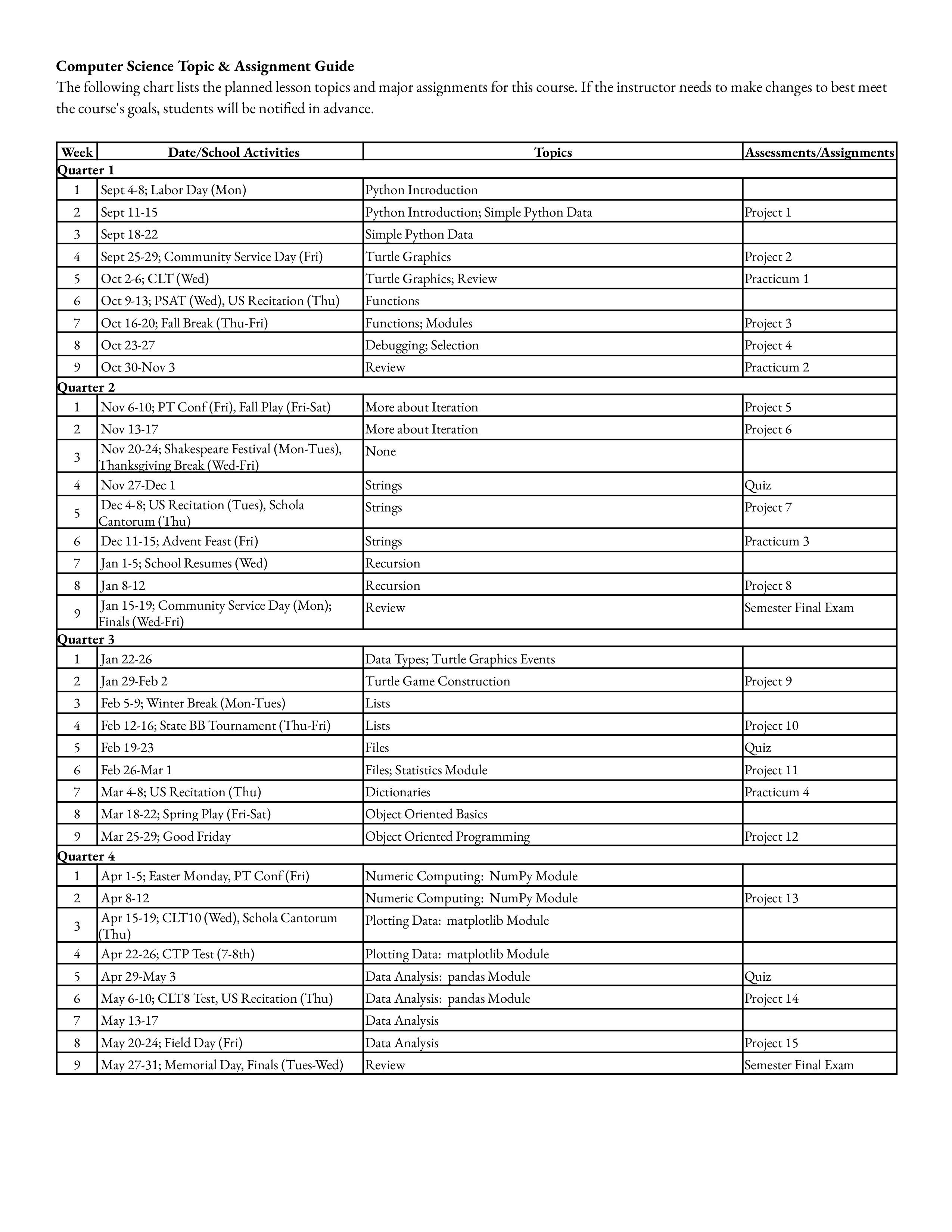Instructor
- Sam Koenen
- Email: sam AT petraacademy DOT com
Online Learning Resources
- Course Website - https://mrkoenen.github.io/class/
- Learning with Python: Interactive Edition (Using Python 3.x) - https://runestone.academy/runestone/books/published/thinkcspy/index.html
- Python 3.11.5 Tutorial/Documentation - https://docs.python.org/3/
Machine Setup
All students will be provided a specialized Chromebook with all the software needed for this class. This machine should be used to complete the work in this class.
Students who wish to setup a personal Chromebook can follow this tutorial: Setup a Python Chromebook
Students who wish to setup a machine other than a Chromebook will need to install the following software. Be sure to talk to Mr. Koenen about your plans to get important advice first.
- Python 3.11.5
- Visual Studio Code
- Git
- Additional Python packages:
- python3-pip3
- python3-dev
- python3-venv
- numpy
- matplotlib
- pandas
Course Description
This course introduces students to computational thinking, which is a way of solving problems using computers. It also explores the nature of computers as tools and how these tools can be applied to some problems in data science. This course is also a dual enrollment course, meaning students may earn up to 7 credits at Montana State University for passing this course. The dual enrollment credits are optional, and they do have a nominal credit fee.
Course Outcomes
- Understand what computational thinking is and how it helps us solve a variety of problems.
- Design and implement short programs in an interpreted language such as Python.
- Use several of the most common Python modules to solve problems and analyze complex sets of data.
- Develop a better understanding of how computational thinking and programming are essential tools in many fields of study, both technical and non-technical.
Dual Enrollment
A dual enrollment course means that students take a single course but are enrolled in and earning credit at two different schools for the course. If students choose the dual enrollment option for Petra’s Computer Science course, they will also be enrolled at Montana State University. This means they will use all of MSU’s websites and tools to pay tuition, access transcripts, etc. Mr. Koenen is a qualified dual enrollment instructor for MSU and Gallatin College, but an employee of Petra. He can help students with transcripts and questions about the Petra portion of the Computer Science course and will help students enroll in the dual enrollment portion of the course, but he won’t be able to help students with tuition payments, transcripts, or questions about their student account.
Dual Enrollment Orientation Packet for Students 2023-2024
Study and Work Expectations
This is a two-semester college level course, with the same curriculum and assignments as MSU’s version of these courses. Though assignments are distributed evenly through the semesters, there is not as much daily work in this class as in other Petra classes. This means that students are responsible for studying and reviewing material in this course regularly and for seeking additional help when needed. New concepts in this course build on previous concepts; students must be sure they have a good understanding of concepts before moving on to the next one. Neglecting this study will make the course very challenging.
Grade Calculation
- Assignments (ex. Python projects) - 50%
- Assessments (ex. Practica) - 50% N.B.: The semester final is worth 20% of your semester grade. It has no impact on your quarter grades.
Grading Scale
At the end of the semester, grades will be determined based on your class average as follows. Please note that a semester grade lower than 70% will require remediation for Petra credit; however, there is no option for remediation for MSU credit.
- 93+: A
- 90+: A-
- 87+: B+
- 83+: B
- 80+: B-
- 77+: C+
- 73+: C
- 70+: C-
- 67+: D+
- 63+: D
- 60+: D-
- <59: F
Collaboration Policy
All students should read the Petra Academy Student Handbook, especially the section on plagiarism.
When it comes to Python assignments, you MAY
- Work with the other people on your team if teams are allowed. Each assignment will specify the maximum number of people per team (usually only 2).
- Share ideas with people in other teams.
- Help other teams troubleshoot problems.
You may NOT
- Share code you write with other teams.
- Submit code that someone on your team did not write. This includes code found on the internet and code or ideas from previous students.
- Modify another team’s solution and claim it as your own.
Academic Integrity: Helping each other understand concepts or plan an approach to the projects is encouraged, but a student should never allow another student to copy his completed assignments, even if they are in the same group. This is academic dishonesty, on the part of both students. Any incident of academic dishonesty will result in a grade of zero for the assignment, a notification to the parents, and a formal office visit.
AI Use Policy: The use of any form of artificial intelligence (AI) technology on coursework is prohibited and constitutes academic dishonesty; if you aren’t sure if a technology uses AI, ask your teacher before using it on coursework. (For more information on academic integrity and AI, see the full policy in the Parent/Student Handbook.)
Failure to abide by these rules will result in an “F” on the assignment.
